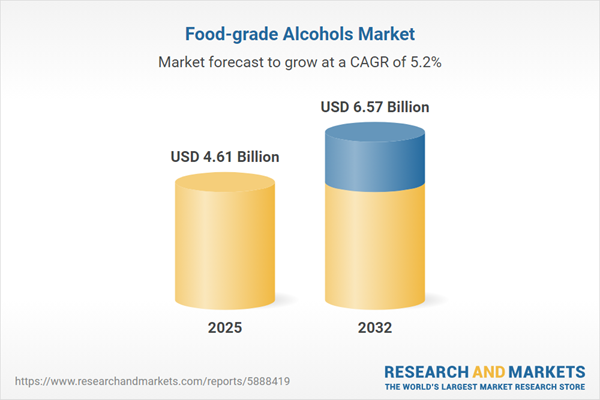Speak directly to the analyst to clarify any post sales queries you may have.
The food-grade alcohol market is essential for organizations prioritizing product safety, quality, and compliance in dynamic food and beverage sectors. For senior decision-makers, navigating evolving standards and supply chain complexities requires informed sourcing strategies and operational adaptability.
Market Snapshot: Food-Grade Alcohol Market Overview
In 2024, the food-grade alcohol market reached a value of USD 4.38 billion, with growth projected to USD 4.61 billion by 2025 and forecasts surpassing USD 6.57 billion in 2032. This trajectory is underpinned by an average CAGR of 5.18%. Escalating compliance demands are influencing organizations to review procurement and production frameworks, while capital investments in both facility expansion and digital capabilities support a more reliable supply chain. The market supports a range of applications spanning food, beverages, and select industrial processes, anchoring consistent quality and operational resilience.
Scope & Segmentation of the Food-Grade Alcohol Market
- Application Areas: Utilized across baking, beverage formulation, food preservation, and confectionery production. These applications foster product innovation and assist organizations in achieving regulatory-compliant launches in evolving markets.
- Alcohol Types: Includes fruit-based, grain-based, and synthetic variants. The diversity enables procurement teams to align sourcing with operational priorities and compliance requirements while managing cost considerations across different sectors.
- Purity Grades: Offered as high-purity (over 99%), intermediate (95–99%), and specialized (below 95%). Each grade serves specific needs in extraction processes, ingredient consistency, and preservation according to unique category standards.
- Packaging Solutions: Available in small-scale, bulk, and industrial volumes. Flexible packaging addresses diverse batch sizes, enhancing distribution agility and meeting the logistical demands of regional operations.
- Regional Presence: The market operates through strong networks across North America, South America, Europe, Middle East, Africa, and Asia-Pacific. This extensive reach secures dependable access and enables organizations to respond to local market requirements swiftly.
- Leading Manufacturers: Archer Daniels Midland Company, Cargill Incorporated, POET LLC, and Green Plains Inc. are prominent suppliers forming the backbone of the supply ecosystem and assisting businesses to adapt to changing sector expectations.
Key Takeaways for Senior Decision-Makers
- Versatile applications allow businesses to diversify product portfolios and adapt offerings, responding to market changes while maintaining regulatory and quality standards.
- Reliable sourcing channels and robust partnerships bolster supply continuity by reducing exposure to regulatory shifts and potential distribution bottlenecks.
- Emerging fermentation techniques and deployment of digital monitoring tools are enhancing operational efficiencies and underpin consistent production outcomes.
- Proactive sustainability measures, like water recycling and optimized resource management, elevate organizational reputation among stakeholders and regulatory bodies.
- Collaborations with technology providers and research agencies raise purification benchmarks and boost traceability, creating more resilient and transparent operations.
- Active surveillance of global and regional developments equips leaders to pivot strategies and respond promptly to market disruptions, supporting ongoing business stability.
Tariff Impact and Global Trade Dynamics
Forthcoming U.S. tariff changes for 2025 are driving procurement teams to deepen supplier relationships, seek diversified collaborators, and invest in vertically integrated production systems. These approaches are designed to limit exposure to trade volatility, thereby supporting stable pricing and supply in a shifting international environment.
Methodology & Data Sources
This assessment is based on verified industry reports, in-depth regulatory analysis, and exclusive interviews with procurement managers, quality assurance leaders, and chemical engineering experts. Proprietary analytics ensure practical, actionable insights for navigating sector dynamics.
Why This Report Matters
- Supports executive teams in anticipating regulatory and market shifts so strategic responses are developed before challenges impact operations.
- Delivers actionable guidance on segmentation and technology trends, optimizing procurement processes and enhancing compliance confidence.
- Provides a critical reference point for evaluating new manufacturing technologies against evolving quality and operational standards.
Conclusion
Focused adoption of technology, careful supply chain management, and strategic collaboration enable organizations to respond to industry changes and maintain competitiveness in the global food-grade alcohol sector.
Additional Product Information:
- Purchase of this report includes 1 year online access with quarterly updates.
- This report can be updated on request. Please contact our Customer Experience team using the Ask a Question widget on our website.
Table of Contents
3. Executive Summary
4. Market Overview
7. Cumulative Impact of Artificial Intelligence 2025
Companies Mentioned
The companies profiled in this Food-grade Alcohols market report include:- Archer Daniels Midland Company
- Cargill, Incorporated
- POET LLC
- Green Plains Inc.
- Louis Dreyfus Company SAS
- Grain Processing Corporation
- Pacific Ethanol, Inc.
- Tereos S.A.
- COFCO Corporation
- Coopérative Agricole Cristal Union
Table Information
| Report Attribute | Details |
|---|---|
| No. of Pages | 191 |
| Published | November 2025 |
| Forecast Period | 2025 - 2032 |
| Estimated Market Value ( USD | $ 4.61 Billion |
| Forecasted Market Value ( USD | $ 6.57 Billion |
| Compound Annual Growth Rate | 5.1% |
| Regions Covered | Global |
| No. of Companies Mentioned | 11 |









